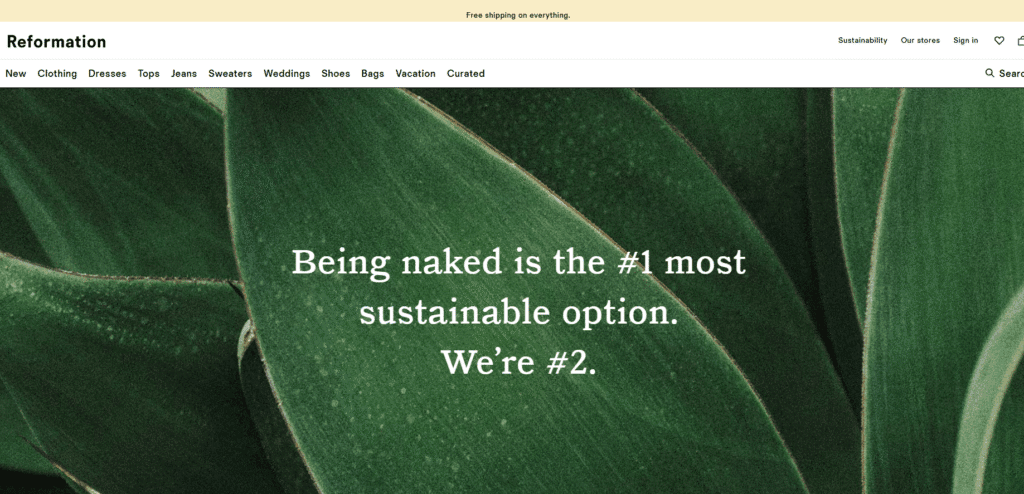It’s a sunny afternoon in mid-July. A model steps onto a white-sand beach, her sleek one-piece swimsuit—not with a shine, but with a quiet confidence. The tag on her suit reads: Recycled Nylon, Made in a Certified Ethical Factory. This isn’t just swimwear—it’s a statement.
Over the past five years, sustainability has moved from a marketing buzzword to a boardroom imperative. And in swimwear, a category deeply entwined with nature and lifestyle, the shift has been especially powerful.
For emerging brands, the question is no longer “Should we consider sustainability?”—it’s “How can we integrate it meaningfully, without compromising on style, performance, or price?”
Let’s talk about why sustainable swimwear isn’t a trend. It’s the future.
Why Sustainability Matters in Swimwear
Swimwear starts where the ocean begins. So it’s only right that the industry takes responsibility for protecting it.
More than 11 million tons of plastic enter the ocean every year (source: UNEP). Traditional swimwear fabrics like virgin nylon and polyester are petroleum-based and non-biodegradable, meaning every cheap bikini discarded after a season could stick around for centuries.
That’s where recycled materials like ECONYL® (regenerated nylon made from fishing nets and textile waste) and Recycled Polyester (rPET) come in. These fibers look and perform like their traditional counterparts—but with drastically lower environmental impact.
Reformation reports that switching to recycled fibers helped them reduce their carbon footprint by 45% in swimwear production compared to virgin synthetics.
For eco-conscious consumers, this matters deeply. A McKinsey survey shows that 67% of Gen Z and Millennial shoppers consider sustainability important when purchasing fashion—and that includes their swim looks.
Lessons from Patagonia & Reformation
You don’t have to reinvent the wheel—just pay attention to the pioneers.
Patagonia, long known for its environmental activism, uses 87% recycled materials across its swimwear line. But beyond fabric, they’re also transparent about fair labor conditions and encourage customers to repair and reuse their gear.

Reformation, with its Gen Z cult following, has made eco-sexy mainstream. Their swim line is 100% made from recycled materials, often spotlighted with phrases like “low-impact hotness” and paired with sustainability reports customers can actually understand

What sets these brands apart? Clarity, certification, and consistency. They don’t just claim to be sustainable—they show how.
For smaller swimwear brands, working with ethical manufacturers that offer sustainable fabric options, traceable production processes, and third-party certifications (like OEKO-TEX, GRS, or EC REP) can bridge that credibility gap.
Performance, Without Compromise
Let’s be real—sustainability alone won’t sell a swimsuit.
It still needs to:
- Hug the body in all the right places.
- Stay put when diving into waves.
- Dry quickly and feel good against the skin.
The good news? Today’s recycled fabrics are every bit as high-performing as their virgin counterparts. For instance:
- Recycled Nylon: Ultra-soft, strong elasticity, matte or shiny finish.
- Recycled Polyester (rPET): Durable, chlorine-resistant, perfect for prints.
- PBT blends: Long-lasting stretch, ideal for competitive or athletic swimwear.
Many sustainable swimwear factories also offer waterless printing and biodegradable packaging—bonus points for brands looking to deepen their commitment.
With the right fabric supplier and ethical swimwear factory, you can create styles that are as flattering on Instagram as they are kind to the planet.
What Are the Best Materials for Swimwear?
Is Sustainable Swimwear Really That Expensive?
One of the most common concerns among new brand founders is price.
Yes, sustainable materials often cost 10–20% more than standard synthetics. But think long-term:
- Customers are willing to pay more for eco-friendly products—up to 25% more according to IBM x NRF studies.
- A strong sustainability story builds brand loyalty and press value.
- High-quality, responsibly made swimsuits lead to fewer returns and better reviews.
Many modern manufacturers, especially those based in Asia with global certifications(e.g.:china swimwear manufacturer), now offer:
- Low MOQs (as low as 100 pcs per design)
- Rapid sampling (within 10 working days)
- Custom prints on sustainable fabrics
- Support for eco-packaging and traceable production
In short: you don’t need a huge budget or team to create eco-friendly swimwear that sells.
It’s About More Than Fabric—It’s About Ethics

Sustainability isn’t just about recycled fibers.
It’s about:
- Ensuring factory workers are paid fairly and work in safe conditions.
- Reducing overproduction through made-to-order models
- Being transparent about your supply chain.
Ethical swimwear means partnering with factories that:
- Allow third-party audits.
- Sign NDAs to protect your design IP.
- Are willing to disclose their production process.
Buyers are no longer just buying swimwear—they’re buying into values. Make sure yours align with theirs.
So, How Can You Start?
If you’re building or scaling a swimwear brand in 2025, here’s Step-by-Step Guide:
1.Define Your Brand Values and Market Niche
Are you targeting eco-conscious millennials, surfers who care about ocean health, or women who want ethical yet stylish bikinis? Your brand story should be clear and consistent — from your messaging to your materials.
2.Choose the Right Sustainable Fabrics
Choosing fabric is one of the most critical decisions for your swimwear brand — it affects everything from comfort to environmental impact.
How to Choose the Right Swimwear Manufacturer for Your Brand?
3.Find a Reliable Sustainable Swimwear Manufacturer
Your manufacturer can make or break your brand — especially in sustainability.Give preference to swimwear manufacturers with environmental certifications
4.Develop Samples and Test Your Designs
Start with 1–3 styles and test the fit, fabric, and feedback. Sustainable doesn’t mean boring — you can still custom with color, cuts, and details while using eco-friendly materials.
5.Design Eco-Friendly Packaging and Shipping
Your sustainability journey doesn’t stop at the swimsuit. Customers notice how products are packaged and shipped.
6.Launch and Promote Your Brand Online
Use your sustainability story as a marketing advantage. Create content that educates customers about recycled materials, ethical production, and how their purchase makes a difference.
Final Thought
Sustainable swimwear is not about following a fleeting trend—it’s about designing a new system. One that respects the ocean as much as it celebrates the body.
And here’s the truth: you don’t need to be perfect. You just need to start.
Whether it’s one recycled bikini at a time or a full product line overhaul, your choices ripple outward. They shape what the swim industry looks like tomorrow.
FAQ
Q1: What is sustainable swimwear made from?
A:Most sustainable swimwear uses recycled materials like Recycled Nylon (e.g., ECONYL®), Recycled Polyester, or biodegradable packaging.
Q2: Is recycled swimwear as durable as regular swimwear?
A: Yes! Recycled fabrics often perform equally or better in elasticity, UV resistance, and colorfastness.
Q3: How do I know if a factory is truly eco-friendly?
A: Look for certifications like OEKO-TEX®, GRS, and EC REP, and ensure supply chain transparency and ethical labor practices.
Q4: Do sustainable swimwear options cost more?
A: While initial costs may be slightly higher, long-term benefits in branding and customer loyalty make it a smart investment.
Q5: Can I customize my designs using eco-friendly materials?
A: Absolutely. Many ethical factories now offer custom swimwear with low MOQs and sustainable fabrics.
Q6: How can I start a sustainable swimwear line?
A: Begin with small-batch orders, choose the right fabric (e.g., recycled nylon), partner with an ethical manufacturer, and promote your values transparently.

